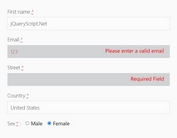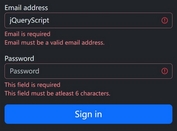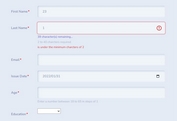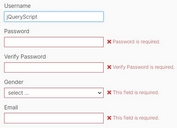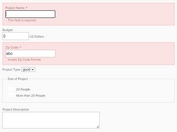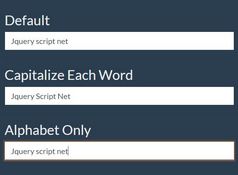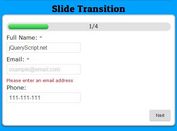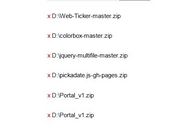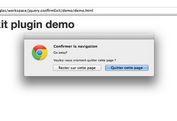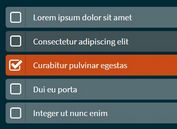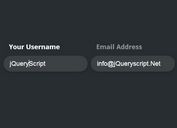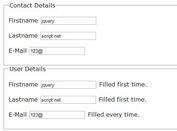jQuery Plugin For Easy Client Side Form Validation - bValidator
| File Size: | 32.9 KB |
|---|---|
| Views Total: | 12214 |
| Last Update: | |
| Publish Date: | |
| Official Website: | Go to website |
| License: | MIT |
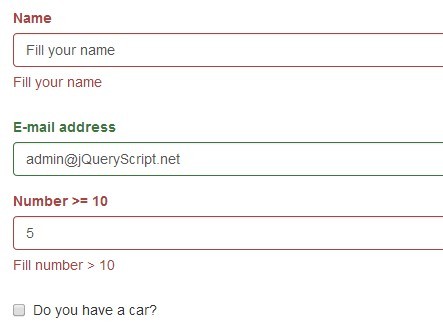
bValidator is a simple jQuery plugin for executing client side validation as you submit a form, displaying error & hint messages next to the invalid inputs.
How to use it:
1. Include the jQuery Javascript library and the jQuery bValidator plugin at the end of your document.
<script src="//code.jquery.com/jquery-1.11.1.min.js"></script> <script src="bvalidator.jquery.js"></script>
2. All you have to do is add custom HTML5 data-* attributes to your form controls. The plugin comes with a lot of pre-defined validation rules as shown below. You can also create your own rules using regular expression.
data-bvStrict="email":email address validationdata-bvStrict="phone":phone number validation. 9 digits.data-bvStrict="number":number validation.data-bvStrict="number:1":number > 1data-bvStrict="number::10":number < 10data-bvStrict="number:1:10":1 < number <10data-bvStrict="notEmpty":input can't be emptydata-bvStrict="empty":input has to be emptydata-bvStrict="string":input has to be stringsdata-bvStrict="date:format":date format validationdata-bvStrict="checked":checkbox has to be checkeddata-bvStrict="reg:^[\d]{2,3}$":validate input by regular expressiondata-bvSwitch:placeholderdata-bvAppend:Add suffix to a valuedata-bvPrepend:Add prefix to a valuedata-bvEmpty:Sets value to a character, if input is empty.data-bvTransform:Erasing spaces from value
<form>
<div class="form-row">
<input type="text" data-bvStrict="notEmpty" data-bvSwitch="Fill your name">
<div class="help-block error-message">Fill your name</div>
</div>
<div class="form-row">
<input type="text" data-bvStrict="email" data-bvEmpty="@">
<div class="help-block error-message">Fill valid e-mail address</div>
</div>
<div class="form-row">
<input type="password" data-bvStrict="reg:^.{5,}">
<div class="help-block error-message">Password must have at least 5 letters</div>
</div>
...
</form>
3. Add some CSS to hide the error message on initialization and to style the input fields based on the validation status.
form .help-block.error-message { color: #a94442 }
form .help-block.error-message.error { display: block }
form .help-block.valid-message { color: #3c763d }
form .row.error .error-message { display: block }
form .row.error input { border-color: #a94442 }
form .row.valid .valid-message { display: block }
form .row.valid input { border-color: #3c763d }
form input.error { border-color: #a94442 }
form input.valid { border-color: #3c763d }
form label.error { color: #a94442 }
form label.valid { color: #3c763d }
4. Call the plugin to initialize the form validator.
$('#form-row').bValidator();
5. Available options.
// Selectors
errorClass: 'error',
errorMessageClass: 'error-message',
validClass: 'valid',
rowClass: 'row',
// Hide error after focusing input
onFocusHideError: false,
// If true, add extra on key up validation
onKeyUpValidate: false,
// Other options: 'direct'
domType: 'row',
// Callback functions
onValid: function() {},
onInvalid: function() {},
beforeSubmit: function() {},
onSubmitFail: function() {},
onFocusIn: function() {},
onFocusOut: function() {},
onKeyUp: function() {}
6. Add custom validation rules using validation() method.
jQuery.bValidator.validation('rule_name', function(value, args, elem) {
return true/false;
});
This awesome jQuery plugin is developed by jBenes. For more Advanced Usages, please check the demo page or visit the official website.
